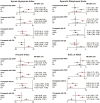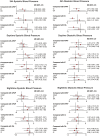Verifying the Relative Efficacy between Continuous Positive Airway Pressure Therapy and Its Alternatives for Obstructive Sleep Apnea: A Network Meta-analysis
- PMID: 28701992
- PMCID: PMC5487413
- DOI: 10.3389/fneur.2017.00289
Verifying the Relative Efficacy between Continuous Positive Airway Pressure Therapy and Its Alternatives for Obstructive Sleep Apnea: A Network Meta-analysis
Abstract
Obstructive sleep apnea (OSA) is a common breathing disorder, and continuous positive airway pressure (CPAP) therapy together with its alternatives has been developed to treat this disease. This network meta-analysis (NMA) was aimed to compare the efficacy of treatments for OSA. Cochrane Library, MEDLINE, and Embase were searched for eligible studies. A conventional and NMA was carried out to compare all therapies. Sleeping characteristics, including Apnea-Hypopnea Index (AHI), Epworth Sleepiness Scale (ESS), arterial oxygen saturation, and arousal index (AI), and changes of blood pressure were selected as outcomes. A total of 84 studies were finally included after rigorous screenings. For the primary outcomes of AHI and ESS, the value of auto-adjusting positive airway pressure (APAP), CPAP, and oral appliance (OA) all showed statistically reduction compared with inactive control (IC). Similar observation was obtained in AI, with treatments of the three active interventions. A lower effect of IC in SaO2 was exhibited when compared with APAP, CPAP, and OA. Similar statistically significant results were presented in 24 h systolic blood pressure and 24 h DBP when comparing with CPAP. Our NMA identified CPAP as the most efficacious treatment for OSA patients after the evaluation of sleeping characteristics and blood pressures. In addition, more clinical trials are needed for further investigation due to the existence of inconsistency observed in this study.
Keywords: Apnea–Hypopnea Index; Epworth Sleepiness Scale; blood pressures; network meta-analysis; obstructive sleep apnea.
Figures





References
-
- Bratton DJ, Gaisl T, Schlatzer C, Kohler M. Comparison of the effects of continuous positive airway pressure and mandibular advancement devices on sleepiness in patients with obstructive sleep apnoea: a network meta-analysis. Lancet Respir Med (2015) 3:869–78.10.1016/S2213-2600(15)00416-6 - DOI - PubMed
-
- Knudsen TB, Laulund AS, Ingerslev J, Homoe P, Pinholt EM. Improved apnea-hypopnea index and lowest oxygen saturation after maxillomandibular advancement with or without counterclockwise rotation in patients with obstructive sleep apnea: a meta-analysis. J Oral Maxillofac Surg (2015) 73:719–26.10.1016/j.joms.2014.08.006 - DOI - PubMed
LinkOut - more resources
Full Text Sources
Other Literature Sources

